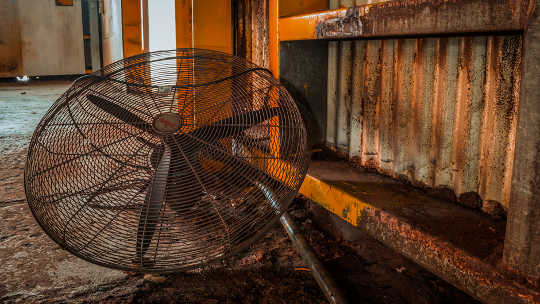Among the many human, environmental, and economic impacts of global climate change, heat stress itself is perhaps underestimated as a major challenge to health and sustainability. Even if the global temperature increase is capped at two degrees Celsius (C), higher baseline temperatures will increase heatwave intensity and associated human health risks. This is especially true in cities, which face particular danger from the urban “heat island” effect — higher overall temperatures due to such factors as dense infrastructure, increased human activity, and lower levels of vegetation cover.
Heatwaves increase rates of death and disease for all populations, but especially for elderly and vulnerable groups, often exacerbating pre-existing health conditions. For example, in the Netherlands, each degree Celsius increase over 16.5C is associated with a 2.7% rise in mortality and a much higher 12.8% increase in respiratory-related disease. In the United States, for each heat-caused death there is another for which heat is diagnosed as a contributing factor. But even these striking estimates are conservative, because heat-related deaths can be easily missed.
Urban hot pockets
The design and construction of modern cities tend to worsen these problems: concrete absorbs and retains heat, lack of vegetation reduces evapotranspiration, tall buildings block wind, and human activity generates waste heat. Average ambient temperatures in cities are up to 3C warmer than surrounding non-urban areas, and at night this difference may rise as high as 12C. This is known as the urban heat island effect, and can be observed at city scale or within particular urban microclimates.
Warmer nights may not seem as dangerous as higher maximum temperatures, but elevated minimum temperatures, which typically occur at night, may be the stronger predictor of heat-related mortality. The urban heat island effect also contributes to more frequent and more intense storms in cities, which can combine with impervious surfaces — generally, man-made structures covered by impenetrable materials such as asphalt, concrete, or compacted soil — to increase the frequency and intensity of flash floods.
The human body is capable of acclimatising to heat, and tropical dwellers are adapted to temperatures that would be extreme in more temperate climates. Still, these populations are vulnerable to heatwaves. In Vietnam, individuals are 28% more likely to die of any cause at temperatures in the 99th percentile (32.4C) than at median temperatures (26.3C). Warm, humid Thailand, sees an additional 4.1–12.8 deaths per 100,000 per month when maximum temperature ranges in the hot season rise from 32.1C–33.4C to 36.3C–37.6C.
In fact, tropical dwellers are uniquely vulnerable to rising temperatures, as climates in these areas are already near the limits of physiological adaptation. The wet bulb temperature (WBT) is a specialised measurement that goes beyond surface temperature (dry bulb temperature) to also account for humidity and evaporative cooling — commonly reported as the Heat Index. Above 35 degrees Celsius WBT — the surface temperature of a human body — neither convection nor sweating will remove heat. This represents a fundamental limit to physiological adaptation. Rising baseline temperatures resulting from climate change and urban heat islands increase the risk that heatwave temperatures will exceed this limit.
A nexus of impacts
Beyond the direct human consequences of rising temperatures, the health impacts of heat are closely interlinked with the environment, the spread of disease, and economic sustainability.
For example, higher temperatures speed up chemical reactions that increase the concentration of ground-level ozone in cities. Higher levels of ozone negatively impact respiratory health by inflaming and damaging airways and aggravating lung diseases such as asthma, emphysema, and chronic bronchitis.
Local and global climate change can also increase populations of disease vectors such as mosquitos. For example, urban heat islands are associated with a higher incidence of dengue in São Paulo, and long-term climate change could allow the expansion of disease vector ranges into previously unaffected regions.
Finally, heat disrupts economic activity, and is poised to create ever-greater productivity losses as it rises. Elevated temperatures reduce the productivity of workers, while also affecting their health. In low-income countries, economic losses due to heat may already be as high as 5.5% of gross domestic product and are likely to increase further in the future.
A call to action
Mitigation of, and adaptation to, heat stress must happen at all levels: regional, national, state, and especially at the city scale. While no city can address climate change on its own, building design, city layout, and land use are critical tools for managing heat exposure for urban dwellers, as are cross-sectoral response plans for more frequent and intense heatwaves.
Green infrastructure that uses natural phenomena to cool cities also offers great promise. This includes green roofs, parks, trees, ponds and lakes, wind corridors, and even innovative technologies for heat exchange such as deep-water source cooling systems.
Unfortunately, given the broad range of issues facing modern cities, heat adaptation is typically left to the individual. Widespread adoption of air conditioning in tropical and sub-tropical cities is, in most cases, the adaptation strategy of choice. This solution is problematic for several reasons: it adds to the urban heat island effect through release of waste heat; it increases energy consumption and thus emissions of greenhouse gases, fuelling climate change; it leaves those who can’t afford it at risk; it turns power outages into potential public health crisis events; and it reduces the demand for more sustainable solutions. This is especially concerning given projected increases in the uptake of refrigerated air conditioning over coming decades.
The intersection between heat, health, and cities remains under-recognised, but processes like that involved in preparing the draft New Urban Agenda for Habitat III — the United Nations Conference on Housing and Sustainable Urban Development — show promise. Whereas initial versions of the Agenda largely ignored heat, the current draft recognises the increased risk of heatwaves due to climate change and the local problem of urban heat islands, and calls for a commitment to “promote the creation and maintenance of well-connected and well-distributed networks of open, multi-purpose, safe, inclusive, accessible, green, and quality public spaces”.
The New Urban Agenda also repeatedly references disaster risk reduction (DRR) and calls for “climate effective design of spaces, buildings, and constructions, services and infrastructure”. These constitute important responses to heat stress, and linkages between DRR and heat management should be explored and emphasised. Such developments are encouraging, as the Agenda will shape thinking on sustainable development for decades to come.
Heat stress is a major health challenge, made worse by climate change — new monthly records have ceased to amaze in this period of steadily rising global temperatures. We compound this problem in the ways that we design, construct, and operate our cities. The costs of inaction will be high. We need a clarion call to action if we are to beat the heat ahead.
About The Authors
Dr David Tan is a Research Officer with the United Nations University International Institute for Global Health focusing on green infrastructure and urban health. He has a PhD In Civil Engineering from the University of Minnesota.
Dr Jose Siri is a research fellow at the United Nations University International Institute for Global Health. He is an epidemiologist focusing on infectious disease transmission, systems thinking and global urban health.
Related Books
at InnerSelf Market and Amazon































